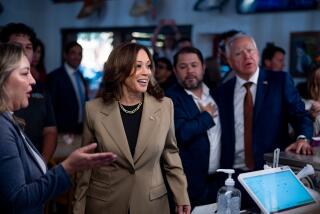Super Bowl XXII : Elite Eateries Scored With Bowl : But Overall, It Wasn’t a Super Week for Restaurants
- Share via
As expected, the elite restaurants of San Diego--the ones where food and drink cost $50 to $100 per person on the average--fared better than their less-expensive counterparts during Super Bowl week, the San Diego Restaurant Assn. said Tuesday.
But overall, the association’s board of directors confirmed that the much-anticipated economic boom from the Super Bowl never occurred.
Paul McIntyre, executive director of the 350-member association, said Tuesday that the organization’s board of directors met in the morning to review the Super Bowl’s aftermath. What they discovered was that the more expensive, well-known restaurants did well from Wednesday through Sunday.
Additionally, business was good in small pockets, such as some areas of La Jolla, or was brisk for brief periods of time, such as at Seaport Village and the Gaslamp Quarter, where large crowds descended for a much-publicized street party Friday night.
“But for a majority of restaurants . . . things were flat or down” during Super Bowl week and the month of January, said McIntyre, reaffirming a belief he and others in the industry had late last week.
No ‘Sour Grapes’
“We certainly don’t want to sound like we’re sour grapes. There’s no doubt the Super Bowl had great benefits as a public relations tool for San Diego, and the (San Diego Super Bowl) task force should be complimented as being a super host,” McIntyre said. “But we as a board want to be very careful” that when the city bids for the event in the future, “there is some system in place where we don’t scare off our traditional customers at the expense of the event.”
What is of particular concern to the association, McIntyre said, is that this is the second time a major event fell short of expectations and, in fact, hurt the industry. The first time was when the Olympics were held in Los Angeles and restaurateurs were told to expect a crush of visitors. “This is the second time that an event has not panned out as we were told,” he said.
Apparently part of the problem is that many fans didn’t show up until much later in the week than anticipated, and that San Diego may have made a mistake in comparing itself to Tampa Bay, which the NFL, the task force and others judged to be the previous Super Bowl host most like San Diego.
‘Huge Capacity for Tourism’
It appears, McIntyre said, that Tampa Bay doesn’t have as large a tourism industry as San Diego and thus its inventory of restaurants is much smaller.
“San Diego has a huge capacity for tourism . . . we handle more in August,” when the city is inundated with more tourists than would come for a Super Bowl “without any problems. We have plenty of hotels rooms and restaurants to eat in then. I think we underestimated our capacity,” McIntyre said.
He stressed that the board made no decision about whether or not it would wholeheartedly support another Super Bowl. Instead, the board wants to make sure that there is better planning next time. “We don’t know the solution yet,” he said.
“We know we’ve made a mistake but I want to make it clear, we’re not mad at ConVis or the task force,” McIntyre said.
More to Read
Go beyond the scoreboard
Get the latest on L.A.'s teams in the daily Sports Report newsletter.
You may occasionally receive promotional content from the Los Angeles Times.










